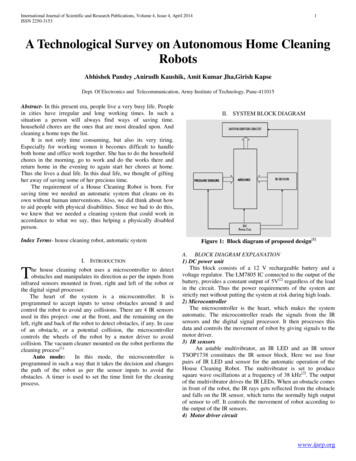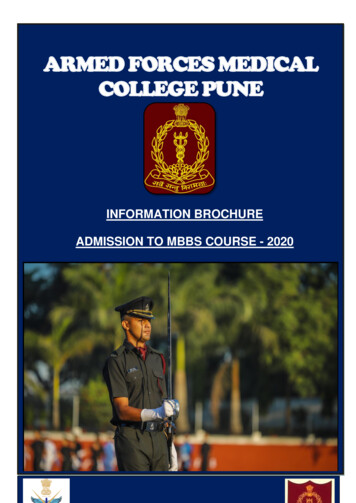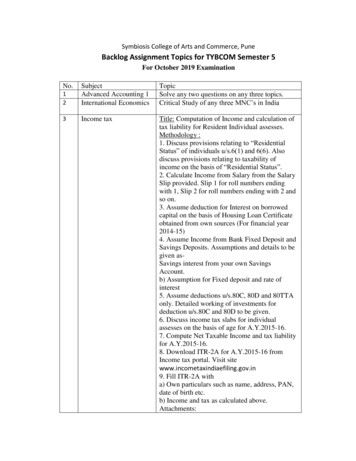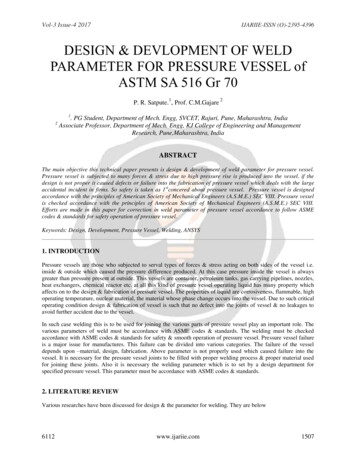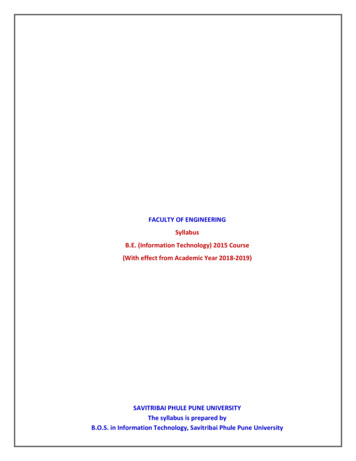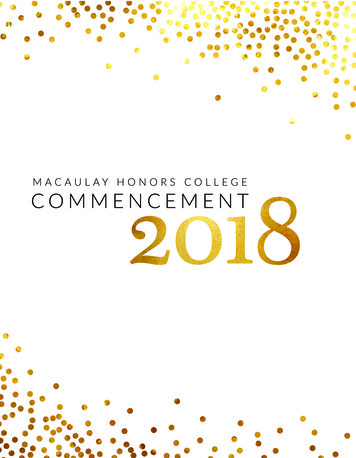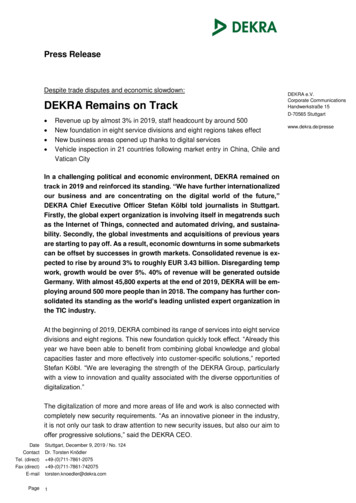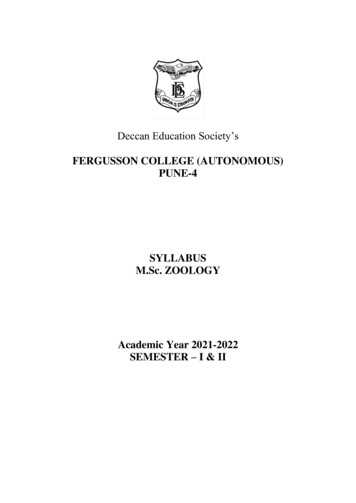
Transcription
Deccan Education Society’sFERGUSSON COLLEGE (AUTONOMOUS)PUNE-4SYLLABUSM.Sc. ZOOLOGYAcademic Year 2021-2022SEMESTER – I & II
Programme StructureSem. Course TitleComparative Anatomy of VertebratesCell BiologyBiochemistryZoology Practical-IZoology Practical-IIAnimal BehaviourMoocs to be selected by studentsAdvanced EndocrinologyTotal CreditComparative Physiology of VertebratesGeneticsDevelopmental BiologyZoology Practical-IIIZoology Practical-IVImmunologyMoocs to be selected by studentsEnvironmental BiologyTotal CreditEvolutionary BiologyMolecular BiologyBiostatistics and BioinformaticsZoology Practical-VZoology Practical-VISkills in Scientific communication andwritingMoocs to be selected by studentsHistology and Histo-chemistryTotal CreditsProject work and Dissertation/ SummerTraining / Institutional trainingsORMoocs to be selected by studentsTotal CreditsTotal Credits Of The -2Elective-1T-Core-4T-Core-5T-Core-6P- Core-3P-Core 4(24)0808(08)80
Program Outcomes (POs) for M.Sc ProgrammePO1PO2PO3PO4PO5PO6PO7PO8PO9Disciplinary Knowledge:Demonstrate comprehensive knowledge of the discipline that form a part of anpostgraduate programme. Execute strong theoretical and practical understandinggenerated from the specific programme in the area of work.Critical Thinking and Problem solving:Exhibit the skill of critical thinking and understand scientific texts and place scientificstatements and themes in contexts and also evaluate them in terms of genericconventions. Identify the problem by observing the situation closely, take actions andapply lateral thinking and analytical skills to design the solutions.Social competence:Exhibit thoughts and ideas effectively in writing and orally; communicate with othersusing appropriate media, build effective interactive and presenting skills to meet globalcompetencies. Elicit views of others, present complex information in a clear and conciseand help reach conclusion in group settings.Research-related skills and Scientific temper:Infer scientific literature, build sense of enquiry and able to formulate, test, analyse,interpret and establish hypothesis and research questions; and to identify and consultrelevant sources to find answers. Plan and write a research paper/project whileemphasizing on academics and research ethics, scientific conduct and creatingawareness about intellectual property rights and issues of plagiarism.Trans-disciplinary knowledge:Create new conceptual, theoretical and methodological understanding that integrates andtranscends beyond discipline-specific approaches to address a common problem.Personal and professional competence:Performindependently and also collaboratively as a part of team to meet definedobjectives and carry out work across interdisciplinary fields. Execute interpersonalrelationships, self-motivation and adaptability skills and commit to professional ethics.Effective Citizenship and Ethics:Demonstrate empathetic social concern and equity centred national development, andability to act with an informed awareness of moral and ethical issues and commit toprofessional ethics and responsibility.Environment and Sustainability:Understand the impact of the scientific solutions in societal and environmental contextsand demonstrate the knowledge of and need for sustainable development.Self-directed and Life-long learning:Acquire the ability to engage in independent and life-long learning in the broadestcontext of socio-technological changes.
PSO1PSO2PSO3PSO4Programme Specific Outcomes for PG Zoology:Academic Competence:(i) Describe fundamental concepts, principles and processes underlying the lifescience its different disciplines.(ii) Understand the evolutionary, genetical, molecular, histological, andbehavioural context of biological thought and research, and thecontributions of physiological, anatomical, immunological and cellularstudies of animals, to the resolution of medical, social and environmentalissues even at molecular level.(iii) Demonstrate a wide range of biochemical techniques, physiologicalprocesses, cellular activities, developmental and evolutionary processes,statistical methods and bioinformatics.Personal and Professional competence:(i)Demonstrate the competence in fundamental zoological skills/techniquesand experimentation using various methods in animal models and theirbehaviour, cell and molecular biology, biochemistry, developmentalbiology and immunology.(ii)Illustrate methods in evolutionary biology, environmental science ,biostatistics and bioinformatics and analyse biological data statistically.(iii)Formulation of ideas, scientific writing and authentic reporting, effectivepresentation and communication skills .Research Competence:(i)Analyse and interpret results obtained in cell biology, molecular biology,biochemistry, genetics, developmental biology, immunology , histology.(ii)Create biological data and skills to explore and authenticate data forexperimental and research purpose.Entrepreneurial and Social competence:(i)Evaluate data of the societal relevance of biological systems and theprocesses and apply the knowledge of zoology in the different fields toaddress problems related to human kind.(ii)Collaborate in various zoological services with demonstration of truevalues of leadership, co-operation, hard work, teamwork etc. during thefield works, surveys and field visits.
Title of theCourse andCourse CodeCO1CO2CO3CO4CO5CO6F.Y. M.Sc. Semester IComparative Anatomy of Vertebrates ZOO4101Number ofCredits : 04Course Outcomes (COs)On completion of the course, the students will be able to:Describe development of kidney and the evolution of kidneys in vertebrate.Define meninges and write development and differentiations of variousparts of brain of vertebrates. Define the hemopoiesis.Explain origin and types of cartilage, development of bones and types ofjoint. Compare skull bones of vertebrates. Discuss various types ofvertebrae of vertebrates. Differentiate the girdles and appendicular bones offrog, Calotes, pigeon and human.Illustrate the origin and development of Alimentary canal.Compare the structure of integuments of vertebrate and list out theepidermal derivatives. Explain various types of epidermal glands andderivatives of vertebrates and explain the functions of epidermal gland andintegument. Compare anatomical details of brain of shark, frog, Calotes,bird and rat. Explain the development of heart and compare heart of shark,frog, Calotes, pigeon and rat.Determine the development of gonads and explain the modification ofgenital ducts in vertebrates.Compile the knowledge of Evolution of Aortic arches of vertebrates,modification of oral cavity and sound producing organs of vertebrates.Unit No.Title of Unit and ContentsIComparative study of Integumentary system andderivatives.Comparative study of structure of integuments of Petromyzon,Amphioxus, Scoliodon, Frog, Calotes, Pigeon and Rat.Epidermal derivatives of Vertebrates.Epidermal glands –various types of glands of vertebrates andtheir functions (e.g. mucous, serous, ceruminous, poison,uropygial, sweat, sebaceous, mammary glands, etc.).Epidermal derivatives -types of scales, feathers, beaks, hair,hoof, horns and antlers, claws, teeth, nails, hooves, and baleen.Functions of integument.Notochord, Cartilage- types and origin of cartilage,Bones; - development of bones and types of joints.Comparative study of skull of Shark, frog, Calotes, pigeon andhuman.Study of Vertebrae of shark, frog, Calotes, pigeon and human.Sternum- origin and comparative study of TetrapodaGirdles and appendicular bones of frog, Calotes, pigeon andhuman.IINo. ofLectures11
IIIComparative anatomy of digestion, respiration andcirculation of vertebratesDigestive system-Origin and development of Alimentarycanal. Parts and modification of oral cavity of vertebrates.Respiratory system-Types of various respiratory organs andsound production in vertebrates.Circulatory system- Hemopoiesis and Development of heart.Comparative study of heart of shark, frog, Calotes, pigeon andrat. Evolution of Aortic arches.1IVComparative anatomy of Excretory, Nervous andReproductive systemsExcretory System-Development of kidney. Evolution ofkidneys in vertebrates.Nervous system: Meninges, Development and differentiationsof various parts of brain. Comparative anatomy of brain ofshark, frog, calotes, bird and rat.Reproductive systems-Development of gonads.Genital ductsin vertebrates.1Refrences:1. Young, J.Z.: Life of Vertebrates. The Oxford University Press, London.2. Parker and Haswell: Text book of Zoology vol. II3. Goodrich. Structure and Development of Vertebrates Vol.I and II.4. Watermann, A.J.: Chordate Structure and Function, Mac Millan Co. New York.5. Weichert C.K.: Anatomy of Chordates 4th edn. MC Graw Hill Books Co. New York.6. Comparative Anatomy of Vertebrates- R.K. Saxena and Sumitra Saxena, Viva Books.7. Comparative Anatomy and Developmental Biology R.L. Kotpal, Sastry& Shukla-Rastogipublication8. Kardong K, Vertebrates: Comparative Anatomy, Function and Evolution, McGraw-HillCompanies, USA.9. Kent CG and Carr R, Comparative Anatomy of Vertebrates, McGraw-Hill Companies,USA.10. Liem KF and Franklin W, Functional Anatomy of the Vertebrates: an EvolutionaryPerspective, Harcourt College Publishers, California.11. Wolff RG, Functional Chordate Anatomy, Amazon Publication, UK.12. Hildebrand, M. (1995). Analysis of Vertebrate Structure. John Wiley & Sons.
Title of theCourse andCourse CodeCO1CO2CO3CO4CO5CO6F.Y. M.Sc. Semester ICell Biology ZOO4102Number ofCredits : 04Course Outcomes (COs)On completion of the course, the students will be able to:Describe the concept of cell biology, protein sorting, cell -cell signalling,cell death, cell ageing. Identify and label components of the cells anddescribe their functions.Differentiate the concept and mechanism of programmed cell death andnecrosis, cytoskeletal material and various transport processes across thecell membrane.Illustrate the biology of ageing, cancer and molecular approaches to cancertreatment. Outline intrinsic and extrinsic pathways of cell death, mechanismof vesicular transport.Identify and draw diagrams of cell membrane and cell organelles andanalyse their functions.Review the process of cell renewal, applications of stem cells, pathways ofsignal transduction, signalling networks.Integrate the knowledge of cellular mechanism with research activities tounderstand and interpret the alterations happening in the cell structure andfunctions due to physical, chemical and ecological factors.Unit. No.Title of Unit and ContentsIOverview of Cells and Cell researchCell as experimental model.Tools of cell biology.Biology of Cell MembranesChemical composition of cell membranes, membranereceptorstransport across the membraneMembrane potentials and nerve impulsesExtracellular matrix; cell-matrix adhesion (integrins, collagenand non-collagen compounds).Cell-cell interaction adhesion junction, tight junction, gapjunction and plasma-desmata; Ca dependent and Ca independent cell-cell adhesion.Protein sortingProtein uptake into the ER, Membrane Proteins and GolgisortingMechanism of vesicular transport, Lysosomes, Molecularmechanism of secretory pathway.Structural and functional organization of intracellularorganelles: Nucleus, Mitochondria, Golgi body, Lysosomes, ER andPeroxisomes.Cytoskeleton and cell movement- Structure andorganization of actin filaments, Actin, myosin and cellmovements. Structure and dynamic organizations ofIINo. ofLectures11
IIIIVmicrotubules, Microtubule motors and movement,Intermediate filaments, Cilia and flagella.Cell-Cell Signalling1Signalling molecules and their receptors. Function of cellsurface receptors.Pathways of intracellular signal transduction, Signallingnetworks.Regulation of cell cycleCell Death-Necrosis, programmed cell death (intrinsic and extrinsicpathway)Cell Renewal- Stem cell and applications.1Biology of Cancer- The development and causes of cancer.Oncogenes, Tumour suppressor genes, Molecular approachesto cancer treatment.Biology of Ageing-Theory of ageing (somatic mutationtheory; error theory; codon restriction theory; gene regulationtheory; free radical theory; telomerase theory).References:1. Molecular Cell, Biology, J. Darnell, H. Lodish and D. Baltimore ScientificAmerican Book, Inc., USA.2. Molecular Biology of the Cell, B. Alberts, D. Bray, J. Lewis, M. Raff, K. Roberts andJ.D. Watson. Garland Publishing Inc., New York3. The World of the Cell, 7th edition (2005), Wayne M. Becker, Lewis J. Kleinsmith,Jeff Hardin. Publisher-Benjamin Cummings.4. Molecular Biology, Weaver R. F., McGraw-Hill Education (5th Ed. 2011).
Title of theCourse andCourse CodeCO1CO2CO3CO4CO5CO6F.Y. M.Sc. Semester IBiochemistry ZOO4103Number ofCredits : 04Course Outcomes (COs)On completion of the course, the students will be able to:Outline concept of Biomolecules, its importance and explain types ofbiomolecules in biological system. Describe structure and properties ofproteins, DNA and RNA.Classify types of enzymes and explain effect of various factors on enzymaticreaction.Illustrate the metabolism of carbohydrates and proteins.Explain Lipid metabolism and its importance. Compare mitochondrial andperoxisomal systems of fatty acid oxidation.Compare α, β and ώ oxidation of fatty acids. Reviewenergetics of carbohydrates and lipid metabolism.Write about the role of enzymes with respect to metabolic reactions.Unit. No.Title of Unit and ContentsIIntroduction to Biomolecules:Classification and Structure of Carbohydrates and conformation ofGlucose molecule, importance of carbohydrates.Structures of Protein (Primary, Secondary, Tertiary, andQuaternary). Protein folding and Stability, Ramachandran Plot.Methods of Protein sequencing.Fibrous and globular proteins.Structure and functions of haemoglobin and myoglobinClassification of Lipids (Fatty acids, triacylglycerol, glycerolphospholipids, sphingolipids, cholesterol, and prostaglandins).Structure of nucleotide.Structure of DNA and RNAEnzymeDefinition & Classification of enzymes.Enzyme catalysis, specificity of enzyme action.Enzyme kinetics and order of reactions, Vmax, Km, MichaelisMenten equation.Factors affecting enzymes activities.Study of Coenzymes, Cofactors, and Iso-enzymes.Regulatory and allosteric enzymes.Enzyme inhibition, bi-substrate reaction.Immobilized Enzymes- advantages and disadvantages.Enzymes as a diagnostic tool.Metabolisms of CarbohydratesGlycolysis pathway and its regulationPentose Phosphate pathway and glucoronic acid pathwayGluconeogenesis.Tricarboxylic acid cycle.Oxidative phosphorylation.Electron transport chain.IIIIINo. ofCredits111
IVEnergetics of glucose metabolismsMetabolisms of ProteinsOrnithine cycle.Transamination and deamination.Lipid metabolism:Mobilization of lipid from adipose tissue.Structure and functions of triglycerides, phospholipids,sphingolipids, prostaglandins, and cholesterol.Mitochondrial and peroxisomal systems of fatty acid oxidationIntroduction to α, β and ώ oxidation of fatty acids.Energetics of fatty acid oxidationRole of carnitine shuttleKetone bodies – Structure and functions.1References:Biochemistry – Lehninger.Metabolic Pathways - Greenberg.Biochemistry – G. Zubay, Addision Wesley Publ. (1983).Biochemistry – Stryer (1988) 3rd Edition W.H. Freeman and Co.Advanced PRACTICAL ZOOLOIGY by J Sinha, A.K. Chaterjee, P Chattopadhyay.(books and Allied publication).6. Boichemistry by Voet7. Campbell, MK (2012) Biochemistry, 7th ed., Published by Cengage Learni8. Campbell, PN and Smith AD (2011) Biochemistry Illustrated, 4th ed., Published byChurchill Livingstone9. Tymoczko JL, Berg JM and Stryer L (2012) Biochemistry: A short course, 2nd ed.,W.H.Freeman10. Berg JM, Tymoczko JL and Stryer L (2011) Biochemistry, W.H. Freeman andCompany1.2.3.4.5.
Title of theCourse andCourse CodeCO1CO2CO3CO4CO5CO6Sr. No.1.2.3.4.5.6.7.8.9.10.11.12.13.14.15.F.Y. M.Sc. Semester INumber ofZoology Practical –ICredits : 04(Comparative Anatomy of Vertebrates and CellBiology ZOO4104Course Outcomes (COs)On completion of the course, the students will be able to:Describe and demonstrate the experiment for preparation of mitotic andmeiotic stages of chromosome and the effect of colchicine on mitosis.Clarify the method of determination of chiasma frequency andterminalization coefficient. Illustrate preparation of blood smear anddifferential count.Demonstrate and illustrate the mechanism of phagocytosis, pinocytosis andsubcellular fraction.Differentiate the skin and integumentary glands, skull of vertebrate animals.Compare and apprise vertebrates of frog and human, pelvic and pectoralgirdles of different groups of vertebrates.Compile the comparative anatomical data of Pisces, Amphibians, Reptiles,Aves and Mammals and prepare a report.Title of PracticalNo. ofPracticalsStudy of skin of Scoliodon, Frog, any one Reptile, Bird and1Mammalian skin with the help of slides.Study of any ten integumentary glands of vertebrates with the1help of specimen / model / charts / pictogram.Study of any ten integumentary hard derivatives of vertebrates1with the help of specimen / model / charts / pictogram.Comparative study of skull of Scoliodon, Frog, Calotes, Gallus1and Human.Comparative study of Vertebrae of Frog and Human.1Comparative study of pectoral and pelvic girdles of Scoliodon,Frog, Calotes, Gallus and Human.Comparative study of limbs bones of Frog and Human.1Comparative study of heart of Scoliodon, Frog, Calotes, Gallusand Rat.Comparative study of urinogenital system of Scoliodon, Frog,Calotes, Gallus and Rat.Comparative study of brain of Scoliodon, Frog, Calotes, Gallusand Human.Comparative study of Genital ducts of Scoliodon, Frog, Calotes,Gallus and Human.Preparation of mitotic chromosomesPreparation of meiotic chromosomesMitosis : Effect of colchicine on mitosis and polyploidySubcellular fraction: nuclei, mitochondria, cytosol and111111112
assaying functional identification of mitochondria.16.17.18.19.Title of theCourse andCourse O4Study of phagocytosis and pinocytosis.Determination of chiasma frequency and terminalisationcoefficientPreparation of blood smears: cell type identification anddifferential counts.Any other practical set by faculty.112F.Y. M.Sc. Semester INumber ofZoology Practical-IICredits :Biochemistry (P core 2) and any one Elective (Animal04Behaviour OR Endocrinology) ZOO4105Course Outcomes (COs)On completion of the course, the students will be able to:Describe concept of standard Laboratory Practices and techniques ofSterilization and of equipments.Estimate different biomolecules by qualitative and quantitative methods.Carry out and examine enzyme reaction and compare the effect oftemperature and pH on enzyme activity.Explain the geotaxis behaviour, orientation responses, feeding responses,orientation responses and observe animal behaviour.Determine blood glucose and liver glycogen levels using suitable model.Perform the calibrations of centrifuge, colorimeter/spectrophotometer, pHmeter. Specify the standardization of different acid and bases.Elective - Animal BehaviourDescribe geotaxis behaviour of earthworm, and outline the orientationalresponses of 1stinstar noctuid larvae to photo stimuli. Identify the soil towhich the earthworm are attracted.Differentiate changes in earthworm responsiveness. Identify and comparethe effect of household and natural solutions on behaviour of ants.Demonstrate orientational responses of 1stinstar noctuid larvae to photostimuliCategorize and classify animal behaviour, and explain Display Behaviour ofSiamese Fighting Fish (Betta splendens)Analyse effect of household and natural solutions on behaviour of antDetermine the median threshold concentration of sucrose solution ineliciting feeding responses of houseflyDesign, and perform experiment by using a choice chamber to investigateanimal responses to stimuli.Elective -Advanced EndocrinologyRecall the basic concepts of endocrinology and histological aspects ofendocrine organs.Explain the basic theory of endocrinological processes with special referenceto hormonal regulationApply the principle and protocols for estimation and determination ofendocrine componentsAnalyse anatomical/histological features and interpret clinical conditions ofhormones.
CO5CO6Sr. No1Determine the hormonal levels of selected endocrine organs and estimatetheir hormonal levelsPerform experiments based on endocrine parameters and prepare a report ofobservationsTitle of The PracticalBiochemistryStandard Laboratory Practices and techniques- Sterilization,Calibrations of measuring glass wares and equipment,centrifuge, colorimeter/spectrophotometer, pH meter.No. ofPracticals123Preparations and standardization of different acid and bases.Qualitative analysis of Carbohydrates.114Quantitative analysis of Proteins.15Quantitative analysis of Lipids.16Estimation of Glucose.17Estimation of Proteins.189Estimation of acid and alkaline phosphatase.Isolations of genomic DNA from Goat liver tissues.1110Estimation of cholesterol.111Demonstration of catalase in Goat liver tissues.112Study of effect of temperature, pH on enzymatic activity.11234567891011Animal BehaviourTo study the geotaxis behaviour of earthwormTo study the orientation responses of larvae/adult animal tophoto stimuli.To study the median threshold concentration of sucrose solutionin eliciting feeding responses of housefly.To study the orientation responses of larvae/adult animal tovolatile and visual stimuli.To study the behaviour of Siamese Fighting Fish.To observe animal behaviour with the help of charts and/orvideos.To study the earthworm response to various environmentalstimuli.Using a choice chamber to investigate animal responses tostimuli.To test effect of household and natural solutions on behaviour ofants.To determine to which type of soil earthworms are attracted.To test the effect of enrichment toy to determine behaviour ofpet.11222122112
*Any other practical suggested by the teacherAdvanced Endocrinology1Histological slides pertaining to endocrine glands.2Blood glucose and liver glycogen estimation by using suitableanimal model and method by inducing diabetes.3Study of male and female reproductive system by using suitableanimal model/ charts.4Histology of Ovary and testes.5Diagnosis of pregnancy by the presence of HCG in Urine byusing suitable method.6Paper chromatographic separation of corticoids.7Study of models pertaining to ART (Assisted reproductivetechniques), Transgenic techniques, STDs and Contraception8Case study relating to particular clinical conditions of hormone.9Visit to Veterinary Institutes to learn breeding techniques.Title of theCourse andCourse CodeCO1CO2CO3CO4CO5CO6Unit. No.IIIF.Y. M.Sc. Semester IAnimal Behaviour ZOO4106111111111Number ofCredits : 04Course Outcomes (COs)On completion of the course, the students will be able to:Describe the behavioural Genetics and social behaviour of animalsExplain and discuss how language evolved in primates and different modesof communication.Illustrate the role of nerves and hormones in controlling behaviour.Classify different behavioural patterns of animals to study and analyseanimal psychology.Review reproductive behaviour and biological Rhythms.Write a report on application of Animal behaviour and outline differentapproaches and methods in study of behaviour.Title of Unit and ContentsAnimal Psychology:Classification of behavioural patterns. Analysis of Behaviour(ethogram). Innate BehaviourBehavioural Genetics:Genes and behaviour. Evaluation of behaviour. Co evolution.Control of behaviour:Neural and hormonal.Communication:Chemical, Visual, AudioEvolution of language (primates)Social Behaviour:Aggregation,Schooling in fishes,Flocking in birdsGroup selection, kin selection, altruism,Social organization inNo. ofLectures11
IIIIVinsects and primates.Reproductive Behaviour:Mating systems. Courtship. Sperm competition. Parental CareBiological Rhythms:Circadian and circannual rhythms. Orientation and navigationMigration of fishes & birdsLearning and memory:Insight learning. Association learning. Reasoning. CognitiveskillsApplications: Application of Animal behavior,Approaches and methods in study of behavior.Molecular applications – proximate and ultimate causation;Altruism and evolution– group selection, kin selection,reciprocal altruism;Neural basis of learning, memory, cognition, sleep andarousal; Biological clocks.11References:1. Alocock, J. Animal behavior: An evolutionary approach, Sinauer Assoc., Sunderland,Mass. USA.2. Bradbury, J.W., and S.L. Verhrencamp. Principles of Animal Communication,Sinauer Assoc., Sunderland, Mass. USA.3. Clutton-Brock, T.H. The evolution of Parental care, Princeton Univ. Press, Princeton,NJ, USA.4. Eibl-Eibesfeldt, I. Ethology. The biology of behaviour, Holt, Rinechart& Winston,New York.5. Gould, J.L. The mechanisms and evolution of behaviour.6. Hauser, M. The evolution of communication, MIT Press, Cambridge, Mass. USA.7. Hinde, R.A. Animal behaviour: A synthesis of Ethology and comparative psychology.McGraw-Hill, New York.8. Krebs, J.R. and N.B. Davies, Behavioiural ecology, Blackwell, Oxford, U.K.
Title of theCourse andCourse CodeCO1CO2CO3CO4CO5CO6F.Y.M. Sc. Semester IAdvanced Endocrinology ZOO4108Number ofCredits : 04Course Outcomes (COs)On completion of the course, the students will be able to:Describe endocrine glands, their structural features, hormones secreted byendocrine glands /organs and hormone- Cell receptor mechanism.Explain role of pancreas as endocrine organ, hormones of pancreas andcarbohydrate metabolism and related clinical aspects.Illustrate role of pancreas and thyroid gland, its physiological role andclinical implications.Classify different classes of hormones and their mechanism of action withspecial reference to receptor mechanisms and its processing through signaltransduction.Review reproductive endocrine system and hormone disruptors HumanExposure to environmental factors, and its Clinical ImplicationsWrite a report on hormonal disruptors and associated disorders.Unit. No.Title of Unit and ContentsIGeneral EndocrinologyOverview of endocrine glands and their structural featuresClassification of hormones, effects and regulation- basic conceptsand methodsReceptors and Types- Membrane receptors, nuclear receptors,receptor regulation and signal transduction, second messengers,hormone action and terminationEndocrinology of PancreasCell structure and types, Hormones of Endocrine Pancreas,Hormones involved in Carbohydrate Metabolism, Clinical Aspectsof Endocrine PancreasEndocrinology of ThyroidOrganization in Mammals, Biochemistry and Metabolism ofThyroid Hormones, Physiological Role of Thyroxine and Clinicalaspects of Thyroid FunctionsThe Hormones and ReproductionEmbryology of Gonadal Development, Male and FemaleReproductive Hormones, Female Reproductive Cycle, ClinicalAspects of Reproductive Systems. Environmental EndocrinologyIntroduction, Endocrine Disruptors, Human Exposure, HormoneDisruptors, Clinical ImplicationsIIIIIIVNo ofLectures1111References:1. Haris, C. W. and B. T. Donovan, 1968. The Pituitory Gland. S. Chand and Co.,2. Bentley, P. J. 1985. Comparative vertebrate endocrinology, Second Edition,CambridgeUniversity Press. Cambridge.3. Mac Hadley. 1992. Endocrinology, 3rd Edition, Prentice - Hall Inc. A Simon &Schuster Company, Englewood Cliffs, New Jersey, U. S. A.
4.5.6.7.8.9.10.11.12.13.Ingleton, P. M. and J. T. Bangara, 1986. Fundamentals of comparative vertebrateendocrionology, Kluwer Academic Publishers.Turner, C. D. and J. T. Bangara, 1986. General endocrinology. Saunders InternationalStudent edition, Toppan Company Limited. Tokyo.Barrington, E. J. W. 1985. An introduction to general and comparative endocrinology,Claredon Press Oxford.Bolander FF, Moleduclar Endocrinology, Elsevier, UK.Hadley ME and Levine JE, Endocrinology, Adeson - Wesley Publication, USA.Melmed S. Polonsky KS, Reed P et al., William’s text book of Endocrinology, WilleyBlackwell Publication, UK.Franklyn F. Bolander. Molecular Endocrinology Elsevier - Academic Press.J. Darnell, H. Lodish and D. Baltimore, Molecular Cell Biology: Scientific AmericanBook, Inc. USA.Norris, D. O., Vertebrate Endocrinology: Academic Press, New York.Chandra Negi. 2015. Introduction to EndocrinologyTitle of theCourse andCourse CodeCO1CO2CO3CO4CO5CO6Unit No.IF. Y. M.Sc. Semester IIComparative Physiology of Vertebrates ZOO4201Number ofCredits : 04Course Outcomes (COs)On completion of the course, the students will be able to:Describe the concepts of comparative physiology, its importance,functions of organs and organ systems of different groups of vertebrates.Discuss the structure of skeletal muscles and mechanism of muscularcontraction. Articulate the conduction of impulses through the neuronsand ultra- mechanism of osmoregulation in aquatic and terrestrialanimals.Apply the knowledge of physiology to interpret effect of exercise oncardiovascular activities. Generalize the role of kidney in regulation ofacid base balance, neurotransmitters and their role.Explain the physiology of reproductive activities in vertebrates andanalyse the O2 dissociation curve and its physiological and ecologicalimportance.Compare the functioning of different systems of vertebrate animals.Compile the comparative data of physiological aspects related todigestive, respiratory, circulatory, excretory systems, reproductive andneuromuscular systems.Title of Unit and ContentsNo. ofLecturesPhysiology of digestion and internal transport & gas15exchange.Diges
behaviour, cell and molecular biology, biochemistry, developmental biology and immunology. (ii) Illustrate methods in evolutionary biology, environmental science , biostatistics and bioinformatics and analyse biological data statistically. (iii) Formulation of ide

